December 20, 2019
Air Date: December 20, 2019
FULL SHOW
SEGMENTS
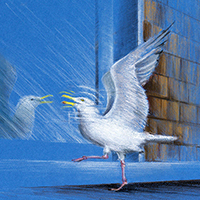
Smeagull the Seagull: A True Story
View the page for this story
Smeagull the Seagull comes to the house near the shore every day and knocks on the sliding glass door. He knocks when he’s hungry and the people who live there feed him. Those humans are Living on Earth’s Explorer-in-Residence Mark Seth Lender, and his wife and illustrator Valerie Elaine Pettis. Their new children’s book Smeagull the Seagull: A True Story teaches young children about the value of experiencing and protecting animals and nature. Mark reads his book aloud, followed by a conversation with Host Steve Curwood about the unusual creatures he's befriended, which include stinging insects as well as Smeagull. (12:27)
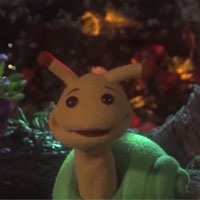
Sammy Snail and the Graneers
View the page for this story
Ventriloquist, puppeteer, and storyteller Lesley Smith and her writing partner Elizabeth Rose bring us the heartwarming tale of Sammy, a young snailie who learns to appreciate his differences as a gift. Bolstered by the wisdom of his grandmama, he uses his talents to explore, protect, and ultimately save his home from the Graneers, a sinister band of rat wolves. (16:17)
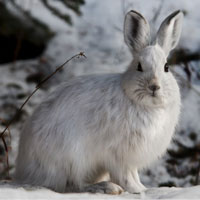
Native American Winter Stories
View the page for this story
Since the beginning of human time storytelling has long been a way to pass down cultural knowledge and myth. Joe Bruchac, a renowned writer and storyteller from the Nulhegan Abenaki tribe, joins Host Steve Curwood to share Native winter stories and traditions. (18:18)
Show Credits and Funders
Show Transcript
HOST: Steve Curwood
GUESTS: Joe Bruchac, Mark Seth Lender, Lesley Smith
[THEME]
CURWOOD: From PRX – this is Living On Earth.
[THEME]
CURWOOD: I’m Steve Curwood.
We’re taking a break from news for some winter solstice story-telling, including a tale about coming of age in a village of snails.
SMITH: They were so happy with plenty of food, family and friends. Everyone except for Sammy. He was a curious, innocent snailie but born different from the others.
CURWOOD: Also, stories from the wisdom of Native American elders.
BRUCHAC: We must listen to our heartbeat, for the sound of the heartbeat is the first drum. And which drum do we hear first? We hear the heartbeat of our mother even before we are born. We’re listening to the music of life and dancing in that water within our mother’s body.
CURWOOD: That and more this week on Living on Earth – Stick Around!
[NEWSBREAK MUSIC: Boards Of Canada “Zoetrope” from “In A Beautiful Place Out In The Country” (Warp Records 2000)]
Smeagull the Seagull: A True Story
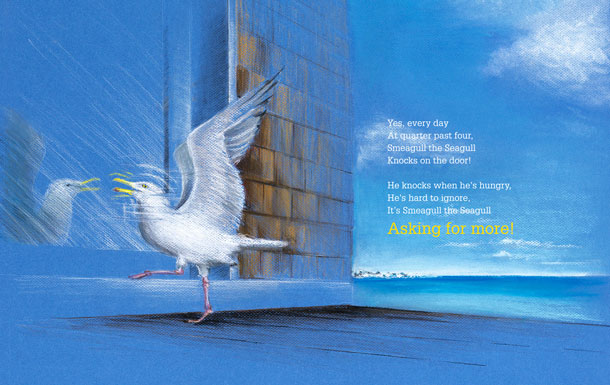
Smeagull the Seagull comes to the house near the shore every day and knocks on the sliding glass door. (Illustration by Valerie Elaine Pettis) Buy a signed copy of Smeagull the Seagull and support Living on Earth
[THEME]
CURWOOD: From PRX and the Jennifer and Ted Stanley Studios at the University of Massachusetts Boston, this is Living on Earth, I’m Steve Curwood.
In this season of the winter solstice in the Northern Hemisphere we are taking a break from the rush of news to share some stories to welcome in the lengthening days. Our theme today is the animals around us, both real and from the hearts of our imagination. We begin with a story by Living on Earth’s Mark Seth Lender about a herring gull that visits his Connecticut home every day, looking to be fed, of course. Here is Mark reading his book, Smeagull the Seagull.
[MUSIC: Smeagull’s Theme. This is a piano composition written by Steinway Artist, Stacey Rose]
LENDER: There's a house near a seawall, facing the shore, and that house has a porch with a sliding glass door. And the people who live there, Valerie and me, stand by that door and look toward the sea.
Because Smeagull the Seagull knows that we know. He comes in the rain. He comes in the snow.
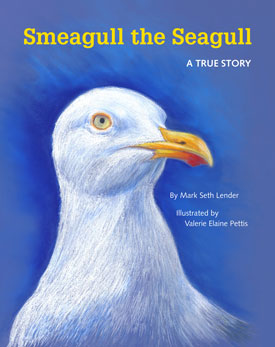
Smeagull The Seagull is available now. (Illustration by Valerie Elaine Pettis)
He comes in summer, I'm telling the truth. He comes when icicles hang from the roof.
He comes in the spring. He comes in the fall. He comes when it's cloudy, and there's no sun at all.
Yes, every day at quarter past four, Smeagull the Seagull knocks on the door. He knocks when he's hungry. He's hard to ignore. It's Smeagull the Seagull, asking for more.
Again in the morning at 10 past 6, Smeagull comes knocking. It's loud as a stick when he knocks with his beak on the sliding glass door. It's Smeagull the Seagull, asking for more.
Wherever you live Seagull is heard. It’s spoken by Smeagull and millions of birds.
I can say I'm tired and I'm going to bed.
I can say I'm hungry and I want to be fed.
I can say I'm angry, angry and mad.
I can say please. I can say I'm so sad.
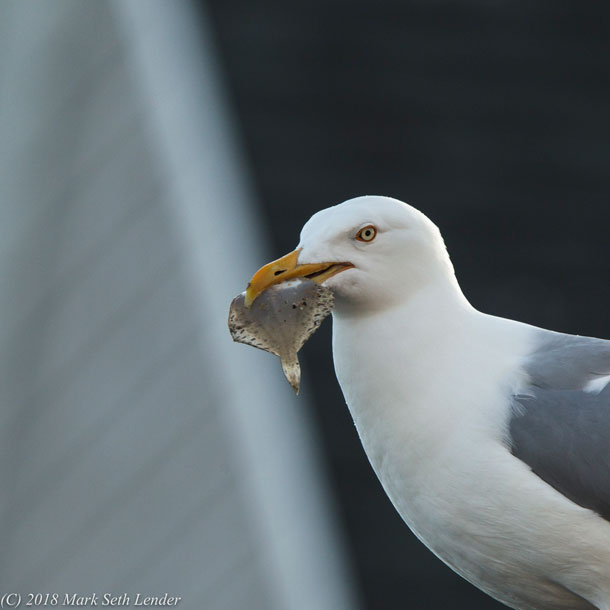
The book is based on the story of the real “Smeagull” who would often greet Mark and Valerie at their Connecticut home. (Photo: Mark Seth Lender)
Some people think they're smarter than birds. But can they speak Seagull? Not one single word.
I was talking and talking. I was all out of breath. So I started knocking, knocking works best. My people know when I knock on the door, it's Smeagull the Seagull, and I'm here for more.
I only eat fish from the Starfish Store. I'm a star, named Smeagull, and I'm ready for more.
Smeagull the Seagull walks down the beach. He lands on the seawall, he flies out of reach. All of the children, all over the town cry, there goes Smeagull! Smeagull’s around!
All that walking and flying keeps Smeagull fit, but it does make him hungry, and he eats quite a bit. So we bought a new freezer, with a really big shelf. Full of fish, for Smeagull, it's all for himself!
It stands in the kitchen from ceiling to floor. We thought we'd be ready when Smeagull said, “more.”
Then Valerie cried “Where’s Smeagull’s fish! The shelf is empty. There's no food in his dish! Starfish will be closing in a minute or two.”
I said, “Start the pickup!” Down the driveway we flew.
Captain Mike had the keys. He was locking the store. He was fresh out of fish. But he said, “I’ll get more.”
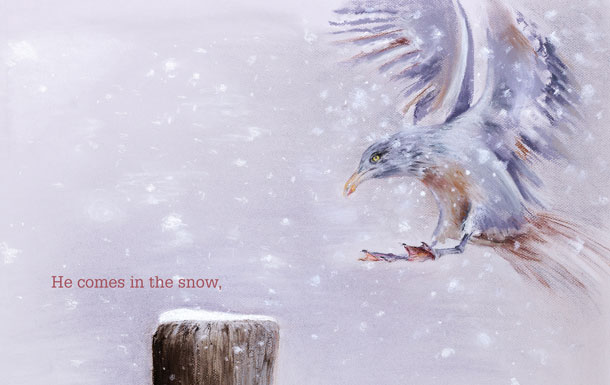
Hungry for scraps of sustainable seafood, Smeagull visits even in a snowstorm. (Illustration by Valerie Elaine Pettis)
So he climbed aboard his boat, the Collette, named after his wife who keeps Starfish as pets.
“Don't worry,” he said, “we're not finished yet, I'll head out to sea, and see what I get.”
The engine roared. He was soon out of sight. “If we have to,” we called, “We'll wait here all night.”
Captain Mike returned with a net full of smelts. “They're fish” he said, “they’re good for your health.”
And he gave us enough to fill Smeagull’s shelf.
We drove home in the pickup with our fish neatly wrapped. Smeagull didn't greet us, was he taking a nap?
All we could do was shake our heads.
“We have to find Smeagull,” was all that we said.
All of the children all over the town helped look for Smeagull. They looked up, they looked down.
They looked in the trees. They looked on the ground. But Smeagull The Seagull was not to be found.
We were tired and hungry, but we couldn't eat. We turned off the lights, but we couldn't sleep.
It was cold, and windy, and day after day, we waited for Smeagull but he'd gone away.
The sea cannot hear you. The sky cannot speak. Life without Smeagull is lonely and bleak.
But what is that sound I hear at the door? That knock, it’s familiar! We ran cross the floor.
“I'm Smeagull The Seagull. I'm back with my seagull. Her name is Shegull. She's a seagull like me. There's an egg in our nest and we’ll soon be a family of three.”
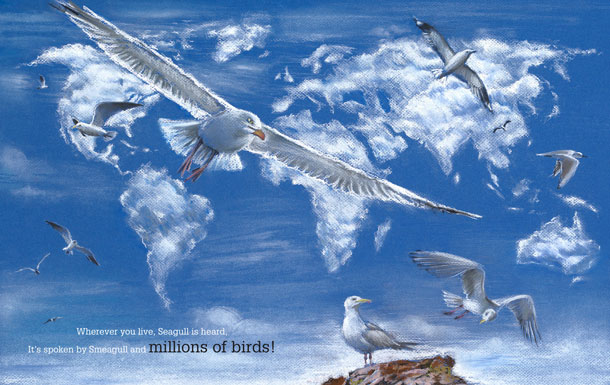
The calls of the gulls are a familiar sound not only at the coast, but far inland. Seagulls are found on every continent including Antarctica. (Illustration by Valerie Elaine Pettis)
There used to be one gull and now there are three gulls. Smeagull, Shegull, and baby gull Megull.
They're our family birds and we love them too much for words.
[MUSIC: Smeagull’s Theme. This is a piano composition written by Steinway Artist, Stacey Rose]
CURWOOD: That's Living on Earth's Explorer-In-Residence, Mark Seth Lender and his story about Smeagull the Seagull. And he joins me now. Hi there, Mark.
LENDER: Hi, Steve.
CURWOOD: So, how did you become friends with Smeagull to begin with?
LENDER: It was kind of his idea. We had begun feeding the migratory ducks about this time of year. And I noticed one particular seagull coming down the seawall, where the ducks were being fed, eating only the corn and only the whole kernels of corn. The next time I saw him, he was eating the sunflower seeds only out of the bird seed, but only the sunflower seeds still within their shells. And I said, oh, this is my kind of bird.
CURWOOD: A picky eater, you mean?
LENDER: Neurotic!
CURWOOD: Neurotic? All right, tell me more.
LENDER: He gave other indications of his intelligence and I thought, you know, he just made himself stand out, I guess is what I'm really saying. He figured out right away that he had my interest. And then I began to feed him fish scraps and the deal was done. He learned when we woke up, and by degrees, he just got our number. And then, oh, I don't know a number of months into the relationship, he would come to the sliding glass door to our little porch. And I would see him, I would hear him, go get him some food. And I would see him studying the glass, and on his own, without being shown anything by us, he figured out eventually that glass had transparency and solidity. And he began to knock. And when he knocks, it's not like a bird pecking at the window. This is the way a human would knock if they really wanted your attention and they were in a hurry. And Smeagull's always in a hurry. So that became the routine.
CURWOOD: Tell me this Mark, at what point did this seagull somehow managed to insert a ring through your nose?
LENDER: He's a very intelligent seagull. And I am prone to nose rings, when it comes to wild animals. You know, I pay a lot of attention to them. I see wild animals as "us", by which I mean closer together with our species, than different from it. A great deal of effort in the history of Western civilization has gone to separating us from the rest of life on earth. And I think that is a gross error. From an evolutionary standpoint, animals like us, which is to say animals with eyes and faces are a very small cohort. They tend to recognize each other. I mean, I have had dealings with paper wasps that clearly know where my eyes are, where my head is, that my thought processes are going on inside that head, and that if they want my attention, that's the place to come to.
CURWOOD: So Mark, you're telling me that you are connected with stinging insects?
LENDER: There's a story I have that I can share with you. Would you like to hear it?
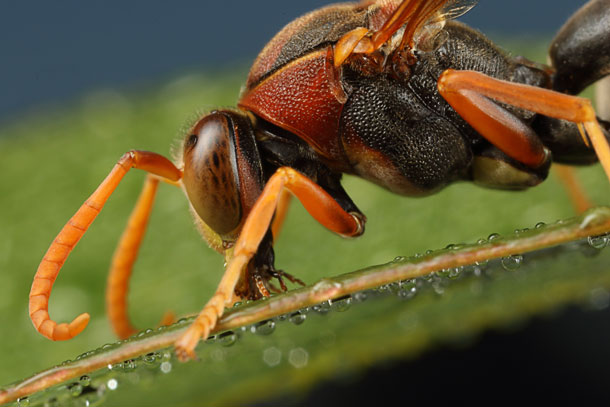
A paper wasp, drinking the dew from a leaf. (Photo: Patrickkavanagh, Flickr, CC BY 2.0)
CURWOOD: Okay.
LENDER: One of those nights.
I woke at two in the morning.
The mind begins working.
I am a friend of the dark. Not that. But what I know goes on in the day. The fate of Nature. The creatures in it. Valerie without whom...
Unable to keep my head up, mid-afternoon, the sun shining I lay down, soon deep and dreaming.
Until the buzzing started.
BZZZZ-zut ZUZ B'ZIZ!
Too throaty and strong and loud to be a fly. Something formidable.
BZZZ-UZ-UZ ZUZ!
I open my eyes:
Paper wasp.
Around my head –
BZZZ-UZ-UZ ZUZ!
-- and to the window.
And around my head --
-- and to the window.
The right window.
Not the solid five-foot pane of insulating glass but the small one alongside, the casement, the one that opens.
I get up, walk over.
Paper wasp is resting on the frame, not at the hinge but at the leading edge. Her wings not beating. Waiting.
Turn the crank --
Window pivots out --
Paper Wasp, escapes.
And everything I thought I knew about Life on Earth is upended.
CURWOOD: Okay, so you've obviously made friends with the paper wasp. Mark, I understand that you've also connected with yellow jackets?
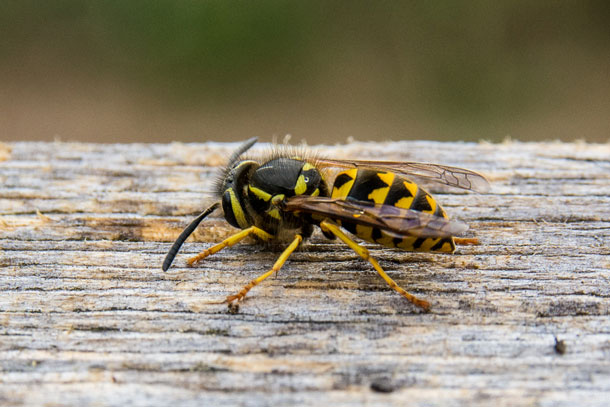
Mark has even befriended the yellow jackets in his home. (Photo: Tyler Ingram, Flickr, CC BY-NC-ND 2.0)
LENDER: Well, after the incident I just told you about I said, well, you know if I can relate to this, then I can probably relate to the rest of them and I began to shoo the yellow jackets who use our houses a thoroughfare at certain times of year. I began to shoo them out. And then I found one morning, two of them just sitting in the bay window, who had not escaped and had dehydrated overnight. And you know, they have a very high metabolism. So they have to eat fairly frequently and they dehydrate, which is their other problem. I ran into the kitchen, got some unfiltered honey and a little bit of water and fed her off my fingers. And she right away knew what I was doing. And her little antennae started working. And she revived and so did the one next to her. I fed that one also. Opened the window, gave them a little clearance, and when I came back about 10 minutes later they had escaped.
CURWOOD: Mark, what kind of a relationship can you really have with insects?
LENDER: Well, enough of one that Paper Wasp figured out that this large hive is occupied by a living creature, who I can show him I want to get out of here and he'll let me. I would say that's quite a bit of relationship. I mean, it doesn't cut the other way. I can't ask them for anything. But they have the capacity to ask me. And that's true of Smeagull the Seagull as well.
CURWOOD: Thanks, Mark. Mark Seth Lender is Living on Earth's Explorer-in-Residence.
LENDER: Thank you, Steve. It's been a pleasure.
Related links:
- Buy a signed copy of Smeagull the Seagull and support Living on Earth
- Mark Seth Lender’s website
[MUSIC: Smeagull’s Theme. This is a piano composition written by Steinway Artist, Stacey Rose]
CURWOOD: Just ahead, a little snail and his big adventure…keep listening to living on earth.
ANNOUNCER: Support for Living on Earth comes from Sailors for the Sea and Oceana. Helping boaters race clean, sail green and protect the seas they love. More information at sailors for the sea dot org.
[MUSIC: Smeagull’s Theme. This is a piano composition written by Steinway Artist, Stacey Rose]
Sammy Snail and the Graneers
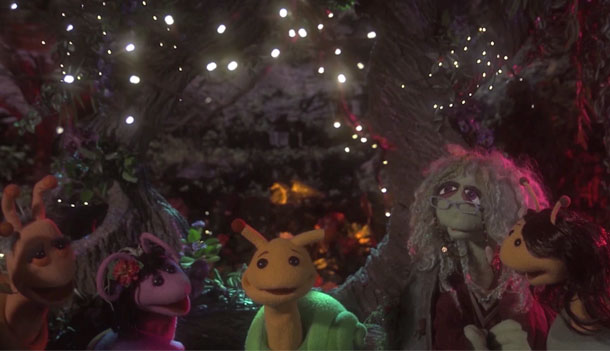
Sammy, surrounded by his fellow snailies and his grandmama. (Photo: Lesley Smith)
CURWOOD: It’s Living on Earth, I’m Steve Curwood.
We continue our special storytelling program in this season of the winter solstice with a tale from puppeteer and creator of Sammy Snail, Lesley Smith. Lesley calls her story Sammy and the Graneers.
[MUSIC: Endless Love, "Natural," by Paul Murray]
SMITH: Even in the darkest of months, we remember the sun. Even in the darkest of times, we remember the light within. Sometimes there can be too much light. And today our story is about a little friend with an overflow of light that got him in and out of a whole lot of trouble.
Deep in the forest lived a village of creatures called snailies. They had brightly colored spiral shells, big curious eyes and two bobbing antenna planted on their fuzzy round heads. They were snail-like, but not slow. Snailies moved fast. And their favorite food was kale and broccoli pizza, and their drink of choice was sparkling pond water on ice. They slid along on their protruding tummies using one muscular foot and leaving a trail of glistening snailie gel. They lived in giant-sized mushroom houses, on paths lined with flowers that lit up like lampposts. They were so happy with plenty of food, family and friends. Everyone, except for Sammy. He was a curious, innocent snailie, but born different from the others. Sammy's antenna were supersized. The other younger snailies made fun of him calling him 'waggle head,' 'tentacle brain,' and other unkind names. When he was small, his antenna were so big they tripped the other snailies while they were playing games of soccer. 'Oh, hugger mugger' snailies would shout, meaning Sammy was messing things up again. This made Sammy lonely.
LIZZIE: "We won't let you sit with us on our picnic blanket, Sammy," said Lizzie. "You and your big antenna take up much too much room."
SAMMY: “All I have is a little dish towel, Lizzy," Sammy complained. "I don't even have enough room for my food."
LIZZIE: "That's too bad, isn't it? You just don't fit in with us."
SMITH: Sammy went to his grandmama.
SAMMY: "I think something's wrong with me."
GRANDMAMA: "What do you mean dear," Grandmama asked.
SAMMY: "My rotten antenna are too big. Nobody wants to play with me.“
GRANDMAMA: "That must feel terrible Sammy."
SAMMY: "It makes my eyeballs hurt."
GRANDMAMA: "I think your big antenna are beautiful and very good."
SAMMY: "Good for nothing."
[MUSIC: Sir Cubworth, "Everything is Fine"]
SMITH: Even though he was sad, he climbed trees with birds followed lizards through the grass and floated on the lily pads next to the painted turtles. His big antenna grew to sense a world of vibrations that others just couldn't hear. One day, his antenna trembled. And Sammy heard a voice crying out. He tracked the sound through a meadow and found a firefly trapped in a sticky spider web. Sammy pulled it to safety just as the spider snapped.
FIREFLY: "Thank you friend," squeaked the firefly as it zipped away.
[MUSIC: Asher Fulero, "Web Weaver's Dance"]
SMITH: Sammy rushed home to tell his village.
SAMMY: "My big antenna are good for something. I helped a firefly escape from a spider."
SMITH: The little snailies barely looked up from their games.
SAMMY: "Oh, forget about it."
SMITH: He couldn't wait to practice with his antenna again. This time, he went deeper into the forest. His antenna felt a moaning tiger at a far distance.
BEAVER: "Help me help me, I'm stuck!"
SAMMY: "A tiger? Is stuck? Oh dear."
SMITH: Sammy rushed towards the moans and discovered it wasn't a tiger. It was a hefty beaver trapped under a collapsed wall of rock.
SAMMY: "Stop slapping your tail so I can help you Mr. Beaver."
BEAVER: "You're too little. What can you possibly do?"
SMITH: He quickly smeared the beaver's shoulders with snailey gel and zapped the beaver's behind with his electrified antenna. The beaver shot out of the wall like a rocket ship.
BEAVER: "Whoa, thank you little friend," he said as he disappeared into the inky black water.
[MUSIC: Asher Fulero, "Web Weaver's Dance"]
SMITH: Sammys antenna flashed and sizzled again. Faraway, there was a roar.
SAMMY: "A crying lion? Could it need help?"
[MUSIC: Poison, "Ladybug Arrives"]
SMITH: Sammy zoomed towards the lion and discovered it wasn't a lion at all. It was a distressed red bird. A cardinal, roaring at weasels threatening her babies. They had fallen from their nest.
CARDINAL: "You get away from my babies you weasley weasels," she chittered.
SMITH: Sammy distracted the weasels with a flash from his antenna, and the mother bird batted the weasels away.
CARDINAL: "You saved my babies,"
SAMMY: "I did?"
CARDINAL: "Yes. Oh, so lucky for us you came along when you did. Thank you.
SMITH: As she flew off, Sammy thought, 'maybe my antenna aren't so bad after all.' At which point, they shimmered, blazed and sparkled, and he heard a deep growl far, far away.
SAMMY: "Yahoo! I think I hear a bear. Sammy to the rescue!"
SMITH: Off he went full snailey speed ahead towards the thud, thud, thud deep in the green forest. He skirted a giant beech tree, but tripped on its roots.
[MUSIC: Biz Baz Productions, "Apprehensive at Best," Jennifer Hopper]
SMITH: As he looked up, he saw a band of rat wolves, an animal he had never seen before. They had red, beady eyes, pointed, ratty ears, smelly wolf fur, and long hairless tails. They circled together on a dusty riverbank. Sammy slithered ever so quietly into the dry leaves to hide from them. He carefully poked his antenna out to hear their vibration. The hairiest rat wolf was shouting.
GROG GRANEER: "Listen up Graneers. I, Grog Graneer, your fearless leader, have a treat for you. Tomorrow night, under a foggy, cloudy sky, there will be no moonlight. We will be free to travel to a nice village of simple-minded creatures called snaileys."
SMITH: The Graneers laughed through their long fangs and whiskers.
GROG GRANEER: "They have delightful homes, inside giant mushrooms, perfect for our comfort, stocked with yummy food. We will kick them out of their houses and take over the village, and the village will be ours. Graneerification!"
SMITH: The rat wolves cheered. Sammys antenna wiggled and glowed.
SAMMY: "Oh no, don't do that antenna. No!"
[MUSIC: Doug Maxwell, "Etherial Choir Ascends", Media Right Productions]
SMITH: But his antenna beamed like lightsabers, shimmered and sparkled with so much light that Sammy was sure he would be caught. But it was the Graneers writhing in pain as they looked in Sammy's direction. The light hurt their eyes and they ran.
SAMMY: "They can't stand my light. But wait, I have to warn everyone. They're coming to take over our village."
SMITH: Sammy slithered as fast as he could the whole way home without stopping. Then he went from mushroom to mushroom knocking on doors and crying out.
SAMMY: "Danger, danger. A band of rat wolves called Graneers are coming tomorrow night and they're planning to take our village."
SMITH: Snailies just looked at him, shook their heads and slammed their doors shut.
SAMMY: "What is the matter with you?"
SMITH: Lizzie snailie approached.
LIZZIE: "I suppose you think you can trick us. There's no such thing as a rat wolf. You should be ashamed."
SMITH: Sammy found Grandmama.
SAMMY: "Why don't they believe me?"
GRANDMAMA: "I don't know dear, but it will work out."
SAMMY: "How?"
GRANDMAMA: "Every creature has a weak spot, something that stops them. What do you think the Graneers' weakness is?"
SMITH: Sammy told her how his antenna flared like firecrackers when they first met.
SAMMY: "They are afraid of light. It hurts their red eyes."
GRANDMAMA: "So, we need bright light don't we? When are they coming?"
SAMMY: "Tomorrow night under a foggy, cloudy sky."
GRANDMAMA: "Well, the light of the moon doesn't go away just because it's cloudy."
SAMMY: "Thank you Grandmama, I have an idea!"
SMITH: Sammy ran into the forest.
[MUSIC: Nate Blaze, "Boundless Energy"]
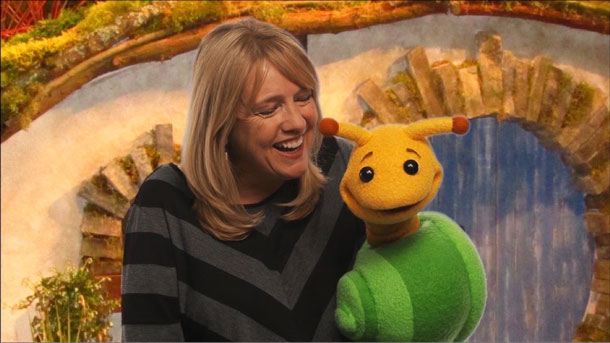
Sammy is a recurring character in Lesley’s work across a variety of media. (Photo: Lesley Smith)
SMITH: The next night was dark and foggy as the Graneers ran silently through the deep woods towards the village. Sammy hid out of sight as the Graneers circled each mushroom and knocked at their doors.
GROG GRANEER: "Come out, come out," called Grog Graneer, "or we will come in and force you out."
SAMMY: "Not so fast Graneers."
SMITH: The woods came alive with hundreds of cardinals and every kind of bird imaginable. They flew at the Graneers who staggered and swatted to keep them away. Then his friends, the lizards, beavers and turtles tripped the rat wolves while thousands of fireflies circled their heads. The light was so bright, the Graneers cried out in pain and tightly closed their eyes. One by one, the rat wolves ran from the village as the snailies watched. The snailies rushed over to thank Sammy, who was mighty shook up.
SAMMY: "You always made fun of my big antenna, but they, they, they're my power. And they helped me make all these friends."
SMITH: As he gestured to the forest friends, Lizzie stepped forward.
LIZZIE: "I can see I made a mistake Sammy, and you have two superpowers. Your heart is as big as your antenna. Please forgive me."
SAMMY: "Thank you, Lizzie. I forgive everybody, cuz I love you. You're my family."
SMITH: Sammy was still shaking as Grandmama stepped forward and wrapped him in her arms.
GRANDMAMA: "You can't hide your bright light under a bushel dear, when the light and your goodness are who you are."
SMITH: She looked upon the village of round snailies, their bobbing antenna and curious big eyes all smiling at her. And at Sammy, with his big bright antenna aglow.
GRANDMAMA: And that light is in each and every one of us. We must always let it shine!
[MUSIC: Endless Love, "Natural," by Paul Murray]
CURWOOD: So Leslie Smith, where does that story come from?
SMITH: The story is sort of autobiographical, in that I experienced a lot of bullying and did bully prevention programs for many, many years to help children understand that it's not their fault, and that there's special qualities that all of us have that come out later in life, that light within us, that needs to be explored and discovered and then shared with the world.
[MUSIC: Endless Love, "Natural," by Paul Murray]
CURWOOD: Puppeteer and ventriloquist Lesley Smith. The story Sammy and the Graneers was written by Lesley Smith and Elizabeth Rose.
Related links:
- All things Sammy Snail
- More about Lesley Smith’s work
- More about Elizabeth Rose’s work
[MUSIC: Endless Love, "Natural," by Paul Murray]
CURWOOD: You can hear our program anytime on our website, or get an audio download. The address is LOE dot org. That's LOE dot O-R-G. And we’d like to hear from you: You can reach us at comments @ l-o-e dot org. Our postal address is PO Box 990007, Boston, Massachusetts, 02199. And you can call our listener line, at 617-287-4121. That's 617-287-41-21.
CURWOOD: Coming up –Native America storyteller Joe Bruchac with tales about a rabbit and some bears. That’s just ahead on Living on Earth.
ANNOUNCER: Funding for Living on Earth comes from you, our listeners, and United Technologies, combining passion for science with engineering to create solutions designed for sustainability in aerospace, building industries, and food refrigeration. UTC companies such as Otis, Carrier, Pratt and Whitney, and UTC Aerospace systems are helping to move the world forward. You can learn more about United Technologies by tuning into the Race to Nine Billion podcast; listen at racetoninebillion.com.
[CUTAWAY MUSIC: Denis Solee, “The Christmas Song” on Christmas Jazz: Instrumental Jazz for the Holidays, Burton]
Native American Winter Stories
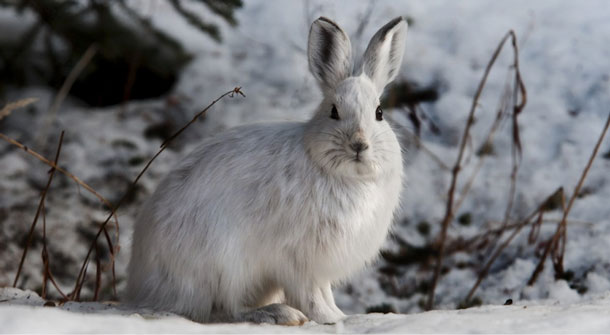
Rabbits are often portrayed as playful and humorous tricksters amongst Native American communities. They have strong hearing abilities and are fast runners, which protects them from predators. (Photo: National Science Foundation, CC By 2.0)
CURWOOD: It’s Living on Earth, I’m Steve Curwood.
Joe Bruchac is an elder in the Nulhegan Abenaki tribal family of upstate New York and Vermont. He’s an author of more than twenty books and a storyteller and he joins us now. Joe, welcome back to Living on Earth. How are you?
BRUCHAC: I'm doing well thank you.
CURWOOD: And you have a story for us for this season.
BRUCHAC: Yes, I do one that seems pretty appropriate considering the snow is falling right now.
CURWOOD: Let's take a listen then please.
BRUCHAC: A long time ago they say rabbit was one of the fastest runners in the forest, and also had a long beautiful tail. But rabbit loved one thing more than anything else. He loved to run around and play in the snow. Now this particular day, the snow had not fallen, and rabbit was disappointed but then he got an idea. His grandmother had told him
RABBIT’S GRANDMOTHER: "Rabbit, sometimes if you want to make something happen, if you sing a song and dance, it will happen for you"
BRUCHAC: And rabbit thought that was a good idea. So he made up a little song and began to dance in a circle singing
RABBIT: "If only it would snow, if only it would snow, then I could run around and play if only it would snow."
BRUCHAC: And sure enough, snow began to fall. And before long, there was enough snow that he could see his footprints going in a big circle. and he was very pleased. But then he thought to himself,
RABBIT: "If a little snow is good, more snow would be better".
BRUCHAC: And so once again, he began to sing and dance in a circle
RABBIT: "if only it would snow, if only it would snow, then I could run around and play, if only it would snow"
BRUCHAC: And indeed, more snow fell, it began to fall even harder with bigger flakes, and soon the whole ground was covered deep in snow. But as rabbit looked around, he said to himself, "
RABBIT: “If a little more snow is better, then a lot more snow would be even better still".
BRUCHAC: And so once again, he began to sing and dance in a circle
RABBIT: "If only it would now, if only it would snow, then I could run around and play, if only it would snow"
BRUCHAC: And now huge snowflakes the size of feathers began to fall from the ground. The snow covered up the bushes, but rabbit kept singing. The snow covered up the bottoms of the trees, but rabbit still kept singing. He looked around and said,
RABBIT: "Hmm, if a not more snow is good, then even more snow would be even better!"
BRUCHAC: And he began again to sing and dance
RABBIT: "If only it would snow, if only it would snow, then I could tun around and play if only it would snow"
BRUCHAC: And now the smaller trees were covered, and soon the bigger trees recovered and finally every tree in the forest was covered with snow. In fact, all you could see sticking up from the top of that snow was the top of the very tallest tree. And that is when rabbit decided he'd done enough. In fact, he was feeling a little tired. He looked around and he said
RABBIT: "Oh, I did a really good job, there is snow everywhere but now I think I should go home and and take a nap and oh, my home".
BRUCHAC: Indeed, where was rabbit's home? It was buried deep under all that snow and he was feeling really tired. But when he looked around, what did he see at the top of that one tallest tree? The fork of that tree sticking up above the snow, and he climbed into that fork of that tree, curled up, wrapped his long, beautiful tail around himself and fell asleep. He slept for a long time. In fact, this was the time of year when the snow begins to disappear. And the sun as it shone down did just that. It began to melt the snow away, down from the tops of the trees down from the middle of the trees down below the bushes and soon all the snow was gone, and rabbit was still asleep in the top of that tree. Before long ago, he woke up, stretched and said,
RABBIT: "Oh, that was really good but now Oh, Oh"
BRUCHAC: He looked around and realized he was in the top of a tree and back then, even as now, rabbits do not know how to climb up trees or climb down. He was stuck up there and unsure about what to do next. He thought:
RABBIT: "Maybe I could sing and dance in a circle but not in this small space".
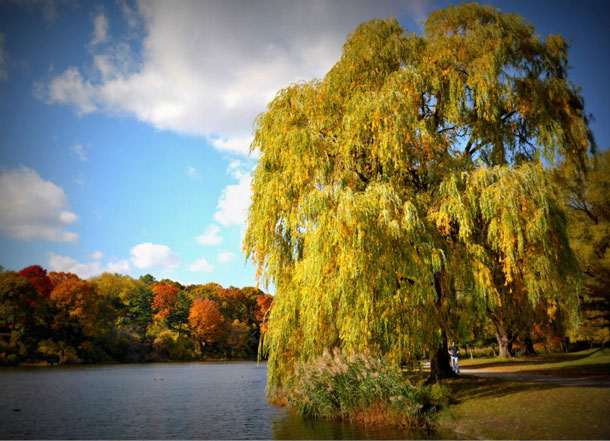
Willow trees prefer cool moist soil and are commonly found near streams, river, ponds, wetlands and floodplains. The rabbit tail story suggests that the elongated leaves on willow trees are rabbit tails that got stuck on a tree branch. (Photo: Jonathan Lines, Flickr, CC By NC ND 2.0)
BRUCHAC: He could not make it snow again with his song and his dance. What could he do? He leaned, leaned, leaned further looking down toward the base of that tree and down there he saw a little green plant growing that looked delicious. Rabbits like to eat green plants and he thought,
RABBIT: "Oh, I'm so hungry if only I could reach that plant found there".
BRUCHAC: He leaned a little further. In fact, he leaned too far, and began to fall. And as he fell, he bounced off one branch, then another branch, and each time he bounced off a branch, a little piece of his tail came free and stuck there. And when he hit the ground, he hit so hard, this front legs got all pushed in, so that now instead of running swiftly, he had to hop and when he looked up in the tree, and saw all those pieces of his tail, and then look back at himself, all he had left was a little round tail where once that long, beautiful tail had been. And so it is to this day, that rabbit has a short tail. Indeed, in the springtime, if you look up into certain trees, some say the pussy willows, others say the cottonwood trees you can see those fluffs left from rabbits tail stuck up there when long ago, rabbit made it snow more than he needed to. And that is how that tail like rabbits ends.
CURWOOD: So, the moral of that story, I guess is be careful what you ask for.
BRUCHAC: Well be careful what you're asked for, but also be satisfied when you have enough too much is not necessarily a good thing.
CURWOOD: No, it isn't. Joe, do you have another story for us today?
BRUCHAC: Well, one story that we tell at this time of year reminds us that we need to take care of our children. In fact, it is said that not that long ago, a mother and a father were out walking in the woods with their little daughter, who was only about perhaps four winters old. We reckon age in terms of winters because if you've lived through a winter, you've lived through a year. And as they walked along, I'm sad to say that mother and that father were arguing with each other. And as they argued over nothing consequential. Their little daughter noticed something. This particular tree she was looking at was really nice looking. She walked over to that tree and she felt how smooth the bark was. She thought, What a lovely tree then she turned around and said, "Mother, Father, look at this, Ooh". They were nowhere to be seen. They were arguing so hard with each other they had kept walking, leaving her behind. In fact, they kept arguing all the way back to their village. And when they got there, the husband said, "my wife, where's our daughter"? And the wife said, "my husband, I thought you were watching her", and they realized she'd been left behind. And just then, it began to snow. And just then the sun began to go down in the sky. They ran back along the trail but the snow was falling so fast they lost sight of the trail itself. They could not find their daughter, they hurried back to the village. They told everyone what had happened. And you know, one child is everyone's child in a village, and everyone in the village came out to help. They lit torches, they walked through the forest, long, long and long but they did not find that little girl. They were sure that she had not survived, for by now the snow was very deep. But the next day when the sun rose, one man who was a very good hunter had not given up, he kept walking along, and then he saw something. What he saw was the base of a hill covered with snow, and from the base of that hill through a little hole in the snow, steam was rising up. He thought he knew what it was. He went, he looked down through that hole in the snow and what he saw was just what he'd expected.
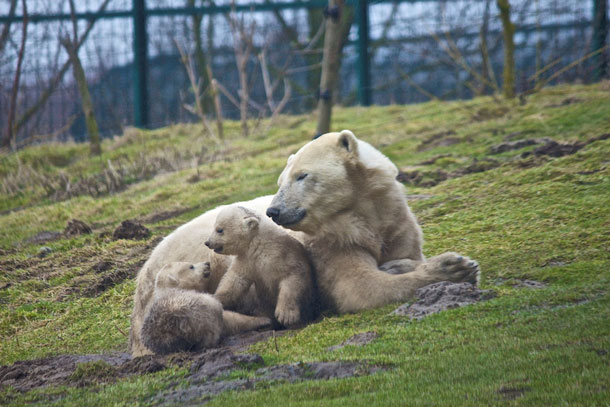
Protecting the young is a quality that both human and animal mothers share. (Photo: Michelle Bender, Flickr, CC By NC ND 2.0)
[FLUTE MUSIC]
It was a mother bear, her breath melted the snow and rose up through that hole as it always does in the winter time. But what he saw, in addition to those cubs made him smile broad, for there was that little girl curled up next to those cubs, warm and safe. He reached down carefully lifted her out and took her home to her parents. Ever since then, we often say when we remember that story that parents should take as good care of their children, as does a mother bear.
CURWOOD: Such an amazing story. When did you first hear that story?
BRUCHAC: I first heard that story about 30 years ago, when I was at out in Wisconsin, a Menominee friend of mine told me that story and said it really happened among their people, it was not a made up story at all. And I have heard other stories, for example, in our Abenaki tradition, about a boy who gets lost or is adopted by the bears, and the bears take care of him until he is finally found by his people. And an old friend of mine named Swift Eagle, who was a Pueblo and Apache elder actually told a story called The Bear Boy about a boy named Kuo-Haya, who was adopted by the bears when he was neglected by his father. So that kind of story apparently travels very well and maybe it's happened more than once.
CURWOOD: Yes, and it's interesting you mentioned the Menominee because among other things, the Menominee are so famous for how they've taken care of their their forests, their woods.
BRUCHAC: Oh yes, they are. In fact Menominee means wild rice people manomin is wild rice, and they are Algonquin speakers as are our Abeniki or Abenaki people. And when the Menominee had their travel recognition taken away from them a number of decades ago, they lost control of their forests. And a lot of them were caught and badly managed. But they managed to regain travel recognition and one of the first things they did was reintroduce the kind of forestry practice they had learned from their elders. Which made sure that the woods would not be clear cut and that they would be used in a sustainable fashion for that gift from the creator of the forest is one that's not meant just for our generation but for all the generations that follow us.
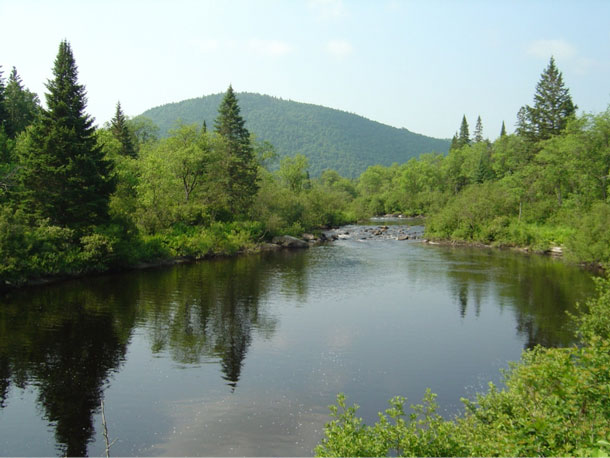
The Nulhegan River is in Northern Vermont, it is surrounded with wildlife like the wild tailed deer, dense moose populations, black bears, and ruffed grouse. Mother Earth can be easily appreciated when looking at a landscape like the Nulhegan River. (Photo: Tom LaPointe, USFWS, Public Domain)
CURWOOD: It's really inspiring. Years ago, I went to visit the Menominee and I met their forester Marshall Pickoff, I believe was his name. And he explained to me that the Menominee only cut the trees that are too old or ill and that as a forester, he was cutting trees that had been designated by the foresters before him that they had been prepared, they would be mature, and that he was going ahead to make preparations for what would be cut in later generations. And I forget the exact numbers but, you know, the Menominee were forced to give up their land, along the lake, Lake Michigan. But they were permitted in negotiations to keep a couple hundred thousand acres of forest land inside. And they decided that this was their legacy forever. And they started with an estimated billion and a half board feet of timber. Over the years, they've harvested over a billion board feet and they have more than what they started with today, because they've only cut with what's too old or too ill to keep growing. It's amazing.
BRUCHAC: Yeah, I should mention that. It was Stephen Marvin Askinet, who was the elder who told me that story when I was visiting Menominee. He since passed on but he was a wonderful tradition bearer. And one thing I I always try to do is to remember to acknowledge those people who shared those stories with me. For example, that rabbit snow dance story can be traced back through people such as Arthur Parker, who was a Seneca storyteller and writer who recorded many of the traditions of his people.
CURWOOD: Well, Joe, we have a bit more time left here and, and I'm wondering if this something else that reminds you of this time of year, the solstice the changing of the season, then getting dark and getting cold and yet all this white that you might want to tell us now?
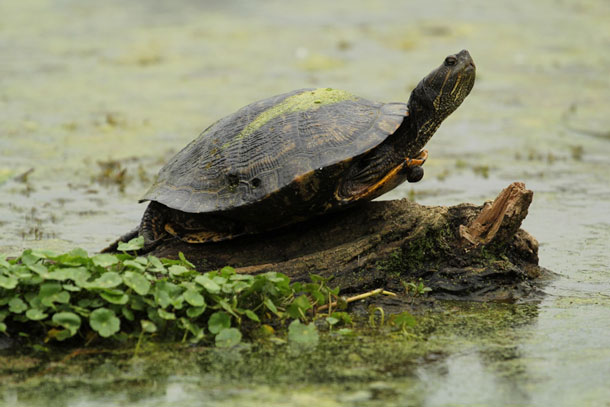
In most Native American communities, the turtle is a symbol of strength fertility and perseverance. There is a strong connection with the turtle and the story of creation. The markings on its back are believed to portray moon cycles. (Photo: Lukas Vermeer, Flickr, CC BY NC SA 2.0)
BRUCHAC: Well, there is a tradition among the Abenaki people which has gone back for a long time, called the New Year's greeting. And it is this when the new year comes, everyone goes from house to house, and they say in the [Abenaki Language]
[ABENAKI GREETING SONG]
Which means, forgive me for any wrong I may have done to you, including wrong that I may not realize I have done to you. For it is important to realize that the things you do affect others around you. And sometimes you may not even know that you've caused a fence or hurt someone's feelings. But at the start of the year, beginning again with those words, were able to have a clean slate, a way forward without carrying the resentment and the unhappiness of the past. In fact, it's like carrying guilt. As a friend of mine who is a Cheyenne elder at Lance Henson told me if you carry guilt, it's like carrying bad water in a cup. You can never fill it again with good water. Instead, pour that guilt out and then do better so that you do not accumulate more of that guilt and you can have fresh water to drink or to share. And that again, is an idea for the beginning of the new year.
CURWOOD: The message is to have a sweet cup. This is the time of year when we celebrate life and, of course women bring life forward, Joe to story perhaps you could tell us along those lines?
BRUCHAC: One of the traditions that I have learned over the years, my Mohawk and other Haudenosaunee, Iroquois elders who are friends of mine, such as Tom Porter, a Mohawk elder, is that the first person who came to this earth was a woman. That long ago there was a land in the sky, and that a woman fell from that sky land, holding in her hand, the seeds of the flowers and plants. The birds flew up to catch her on their back, and then the great turtle swam up from below the surface of the water for only water was here. And animals began to dive down to bring up Earth. The one who succeeded the one who made it was the little muskrat. She brought up a paw full of Earth and put it on the back of the turtle. And then when that woman stepped from the backs of the birds and began to dance in a circle with slow, small steps says women dance today, in the Haudenosaunee tradition they dance like that.
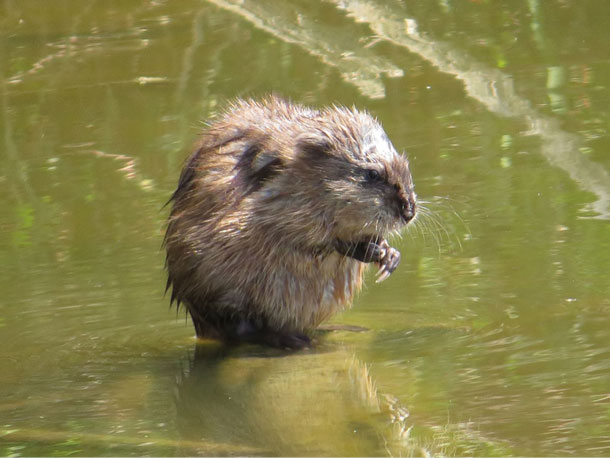
The Muskrat is important to the ecology of wetlands and can be found in a wide range of habitats. (Photo: Jim Kennedy, Flickr, CC By 2.0)
[DRUM]
The earth got bigger and bigger, and where her feet stepped and made footprints, she dropped the seeds, the flowers and the trees and the other plants. So life came to be on earth through the agency of sky woman, who is always remembered among the Haudenosaunee people as a Mother, the first Mother of us all.
[DRUM]
We must listen to our heart beat for the sound of the heartbeat is the first drum and which drum do we hear first, we hear the heartbeat of our mother. even before we are born. We're listening to the music of life and dancing in that water within our mother's body. So when we are born, we're listening for the sound of the drum. We're actually listening to the sound of our mother's heartbeat. The Earth itself when we play the drum, we say the drumbeat is the heartbeat of Mother Earth, and that we as human beings must always remember it when we hear the drum to respect our mothers and respect our Mother Earth.
CURWOOD: Joe Bruchac is a storyteller and Nulhegan Abenaki elder. Joe, thanks so much for taking the time with us today.
BRUCHAC: It was my pleasure, Steve.
CURWOOD: And there's more about Joe's books and stories on the living on earth website that's loe.org
Related links:
- Read more about Joe Bruchac and his stories
- To read more about the Menominee Indian Tribe of Wisconsin, click here
- Click here to read more about the Nulhegan Abenaki Tribe
[MUSIC: Smeagull’s Theme. This is a piano composition written by Steinway Artist, Stacey Rose]
CURWOOD: Living on Earth is produced by the World Media Foundation.
Our crew includes Naomi Arenberg, Bobby Bascomb, Paloma Beltran, Thurston Briscoe, Jenni Doering, Jay Feinstein, Merlin Haxhiymeri, Don Lyman, Isaac Merson, Aynsley O’Neill, Jake Rego, Anna Saldinger, and Jolanda Omari. Smeagull’s Theme was composed and performed by Steinway Artist, Stacey Rose. Tom Tiger engineered our show. Alison Lirish Dean composed our themes. You can hear us anytime at L-O-E dot org, iTunes and Google play- and like us, please, on our Facebook page - Living on Earth. We tweet from @livingonearth. And find us on Instagram at livingonearthradio. I’m Steve Curwood. Happy Holidays!
ANNOUNCER: Funding for Living on Earth comes from you, our listeners, and from the University of Massachusetts, Boston, in association with its School for the Environment, developing the next generation of environmental leaders. And from the Grantham Foundation for the protection of the environment, supporting strategic communications and collaboration in solving the world’s most pressing environmental problems. Support also comes from the Energy Foundation, serving the public interest by helping to build a strong, clean, energy economy.
ANNOUNCER 2: PRX.
Living on Earth wants to hear from you!
Living on Earth
62 Calef Highway, Suite 212
Lee, NH 03861
Telephone: 617-287-4121
E-mail: comments@loe.org
Newsletter [Click here]
Donate to Living on Earth!
Living on Earth is an independent media program and relies entirely on contributions from listeners and institutions supporting public service. Please donate now to preserve an independent environmental voice.
NewsletterLiving on Earth offers a weekly delivery of the show's rundown to your mailbox. Sign up for our newsletter today!
 Sailors For The Sea: Be the change you want to sea.
Sailors For The Sea: Be the change you want to sea.
 The Grantham Foundation for the Protection of the Environment: Committed to protecting and improving the health of the global environment.
The Grantham Foundation for the Protection of the Environment: Committed to protecting and improving the health of the global environment.
 Contribute to Living on Earth and receive, as our gift to you, an archival print of one of Mark Seth Lender's extraordinary wildlife photographs. Follow the link to see Mark's current collection of photographs.
Contribute to Living on Earth and receive, as our gift to you, an archival print of one of Mark Seth Lender's extraordinary wildlife photographs. Follow the link to see Mark's current collection of photographs.
 Buy a signed copy of Mark Seth Lender's book Smeagull the Seagull & support Living on Earth
Buy a signed copy of Mark Seth Lender's book Smeagull the Seagull & support Living on Earth

